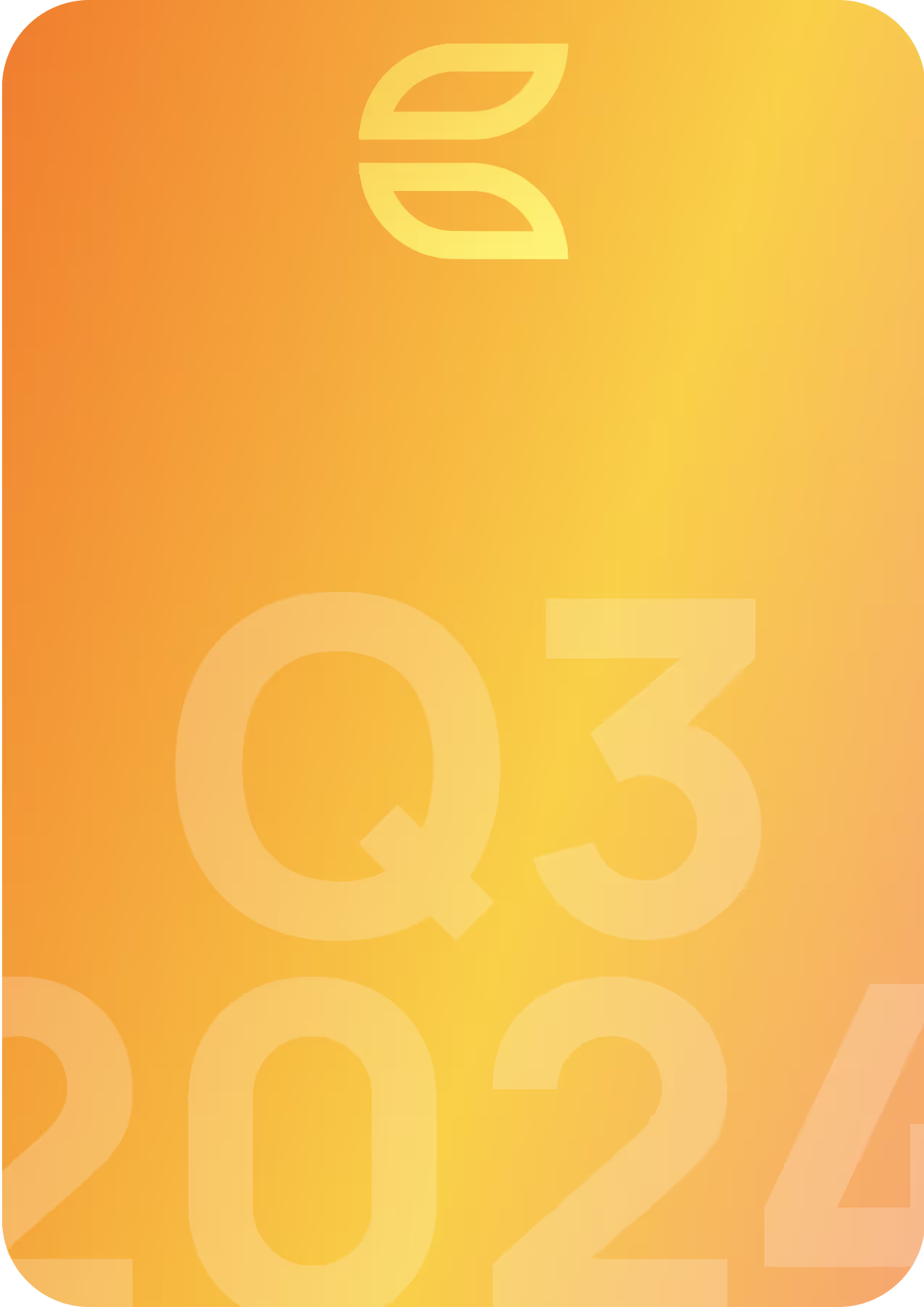2024 Annual Review of the Web3 Hiring Landscape

Exec Summary
The second half of 2024 marked a significant period for Web3, driven by Bitcoin surpassing $100,000 and increasing blockchain adoption worldwide. Pro-crypto policies and new investments have further accelerated growth across the sector.
At Calyptus, job postings increased by over 116%, with more than 250 roles now available, particularly in senior and technical positions like smart contract development and protocol engineering. Salaries remain competitive, especially in North America, and hybrid work setups are gaining traction.
With fresh funding rounds and advancements in AI, DeFi and stablecoin infrastructure, 2025 is set to be a breakthrough year for Web3 companies and talent alike. Businesses focusing on leadership, deep technical expertise, and distribution will be best positioned to win in 2025.
Web3 Salary & Hiring Quick Trends Catchup
In-office roles increased from 3.4% (H1) to 7.3% (H2), and hybrid roles rose from 6.7% (H1) to 16.2% (H2).
Companies are prioritizing periodic in-person collaboration, signalling the beginnings of a shift from fully remote setups.
Average salaries dropped in most roles (e.g., Backend: $147,177, down from $170,968; Management: $159,487, down from $179,615).
Exception: Smart Contract Developers saw a slight increase, averaging $172,297 (H2).
The majority of H2 had companies in a "limbo" stage around budgeting & hiring needs seeing a decline in salaries.
Average US salaries rose to $183,294 (H2), while Europe and Asia saw significant drops to $127,646 and $112,328, respectively.
North America solidified its lead, highlighting its tech ecosystem and demand for senior talent.
Junior roles remained stable (3.8% to 3.5%), while senior roles surged (50.5% to 63.1%), reflecting a focus on leadership and early talent development. Mid-level roles dropped (45.7% to 33.5%), indicating a realignment of workforce priorities.
Companies prioritize senior expertise for strategic goals while nurturing entry-level talent for future growth.
Average Salary by Job Category
Rust, TypeScript, Golang and Python.
Expertise in building scalable systems, development frameworks, and crypto-related software, in system architecture and blockchain integration.
The average salary for backend developers in H2 was $147,177, spanning from $30K to $275K, with the middle 50% earning between $90K and $187.5K.
The average salary for backend developers in H1 was $175,180, spanning from $60K to $310K.
React, TypeScript, frontend development frameworks
Familiarity with native apps and responsive UI/UX design tailored for Web3 integration was valued by employers.
H2 salaries averaged $135,940, with a range from $35K to $275K. The middle 50% earned between $77.5K and $175K.
H1 salaries were slightly higher, averaging $139,891, with a range of $67.5K to $212.5K. The reduction in H2 could be linked to greater availability of frontend talent.
Strategic and technical expertise, often in blockchain-related fields, experience managing teams, building organizational structures, and delivering on crypto-specific projects.
Salaries in H2 averaged $159,487, with a wide range of $70K to $325K. The middle 50% earned between $102.5K and $188.75K.
H1 salaries averaged higher at $179,615, ranging from $110K to $300K. The H2 decline suggests companies may be hiring less-experienced managers or prioritizing budget-conscious hires.
Product design, portfolio creation, and proficiency with tools like Figma
Strong understanding of technical design and crypto-focused projects was critical.
Salaries averaged $149,214 in H2, with a range of $36K to $300K. The middle 50% earned between $115K and $165K.
H1 salaries averaged slightly higher at $161,630, ranging from $85K to $250K. This decline in H2 may indicate increased competition or shift in demand to junior and mid roles.
Solidity, Rust, smart contract development, understanding of blockchain security, EVM, and crypto-specific technologies.
H2 salaries averaged $172,297, with a range of $75K to $255K. The middle 50% earned between $140K and $190K.
H1 salaries were slightly lower at $167,849, ranging from $62.5K to $300K. The increase in average salary for H2 may indicate rising demand for experienced smart contract developers.
Top marketing skills included expertise in DeFi, SEO, and content creation. Experience in blockchain marketing campaigns and technical understanding of crypto markets was highly valued.
Average salary in H2 was $142,500, with a range of $75K to $250K. The middle 50% earned between $90K and $175K.
Sales roles demanded experience in client management, institutional sales, and business development in crypto and DeFi ecosystems.
H2 salaries averaged $100,455, with a range of $25K to $175K. The middle 50% earned between $77.5K and $132.5K.
Note: this does not include bonus pay
Community engagement, technical writing, and familiarity with tools like Solidity
Professionals were expected to have expertise in building developer communities and using platforms like Twitter effectively.
H2 salaries averaged $125,556, with a range of $55K to $210K. The middle 50% earned between $80K and $150K.
H1 salaries were higher on average, at $143,750, ranging from $80K to $180K. This drop in H2 could reflect a pivot towards mid-level roles or lower emphasis on community outreach.
Researchers were expected to have strong technical skills in Python, data analysis, and blockchain modeling. Familiarity with DeFi and crypto markets was a key differentiator.
H2 research roles averaged $152,500, with a range from $60K to $300K. The middle 50% earned between $113.75K and $167.5K.
H1 salaries were higher, averaging $162,857 with a narrower range of $100K to $225K. This drop may reflect increased hiring for junior positions or more distributed research responsibilities.
Highest Salaries Across Web3 Roles
Lowest Salaries Across Web3 Roles
Work Environment Distribution:
The Return of Office Culture


Remote work continued to dominate the Web3 landscape, with 76.5% of professionals opting for this setup in H2. While still the majority, this is a decrease from 89.9% in H1, reflecting a gradual shift toward hybrid and in-office options.
Remote roles remain popular due to the industry's global nature and the flexibility offered to professionals across different time zones. Companies offering fully remote setups continue to attract top talent, but the decline indicates a trend toward more structured alternatives.
Hybrid setups gained traction in H2, accounting for 16.2% of roles compared to 6.7% in H1. This notable increase suggests a growing emphasis on balancing remote flexibility with periodic in-person collaboration.
The shift towards hybrid roles is a clear sign that companies are seeking ways to foster teamwork and innovation while maintaining flexibility. Professionals favoring a blend of work environments may find this setup particularly attractive.
In-office roles rose to 7.3% in H2, up from 3.4% in H1. This increase suggests that certain companies are moving towards traditional office setups for roles requiring closer collaboration or on-site resources.
While still a minority, the rise in in-office roles reflects the demand for structured environments in specific Web3 domains. These roles could be appealing to professionals who thrive in highly interactive and managed workspaces.
For both recruiters and professionals, these trends emphasize the importance of offering and considering diverse workplace options to adapt to the evolving dynamics of Web3 work environments.
Seniority Breakdown in the Web3 Sector
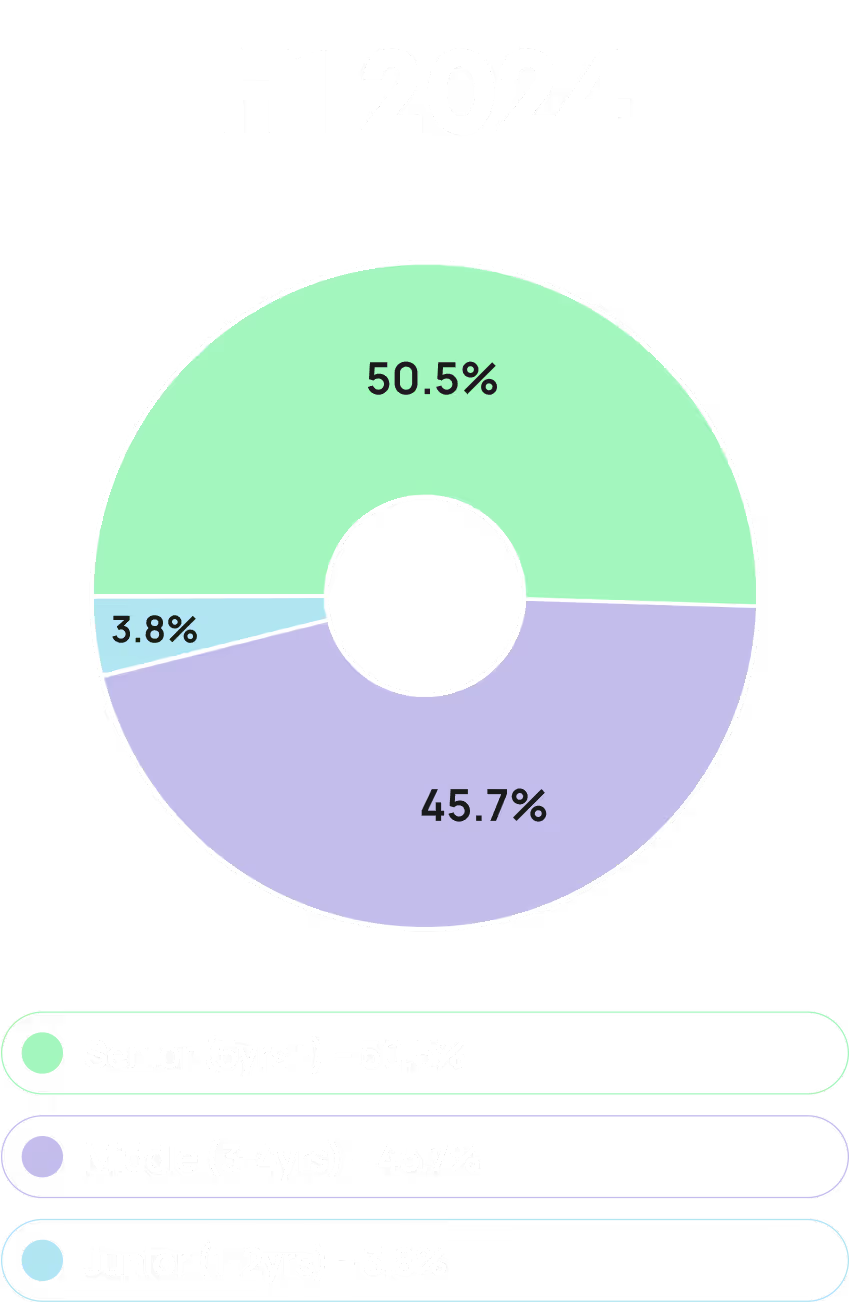
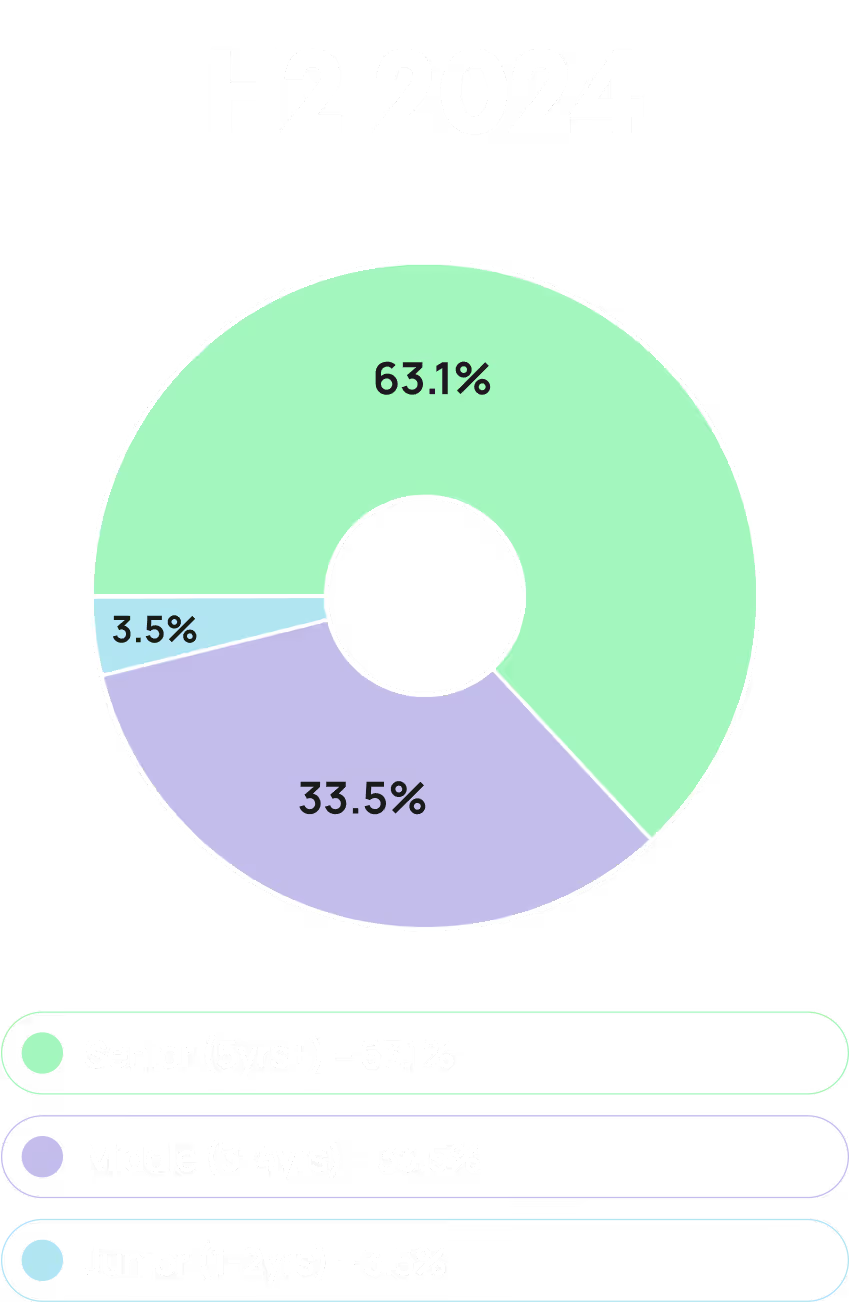
The Web3 sector showed a significant reliance on senior professionals, with 63.8% of roles designated as senior-level positions in H2, up from 52.5% in H1. This reflects the growing demand for experienced leaders capable of navigating the complexities of the Web3 landscape.
The rise in senior roles highlights the need for expertise in managing advanced technologies and strategic initiatives in the rapidly evolving Web3 environment. For job seekers, this trend presents strong opportunities for seasoned professionals to lead impactful projects and drive innovation.
Mid-level roles accounted for 33.9% of Web3 positions in H2, a decrease from 47.5% in H1. While still a substantial portion of the workforce, this shift suggests an increasing focus on senior leadership and a slight reduction in mid-level hiring.
Mid-level professionals remain critical in bridging strategic goals and operational execution. For employers, these roles offer opportunities to cultivate future leaders while maintaining team stability and continuity.
Junior roles made up 3.5% of Web3 positions in H2, a slight increase from 4.0% in H1. Although still a minority, the presence of junior roles indicates an ongoing effort to nurture new talent in the Web3 ecosystem.
The limited availability of junior roles underscores the industry's preference for seasoned professionals. However, the slight increase in H2 may point to emerging initiatives aimed at onboarding and training new talent to support long-term industry growth.
Senior professionals are in high demand, offering excellent opportunities for those with advanced skills and leadership capabilities. Mid-level roles, while reduced, remain crucial for professionals aiming to grow into senior positions. Junior talent should focus on acquiring niche Web3 skills to increase their chances of breaking into the sector.
The strong reliance on senior talent highlights the importance of competitive compensation and a compelling value proposition to attract experienced professionals. Providing career development opportunities for mid-level hires can help foster leadership pipelines, while investing in junior talent could ensure long-term growth and a steady flow of skilled professionals into the Web3 ecosystem.
Geographical Salaries & Job Distribution
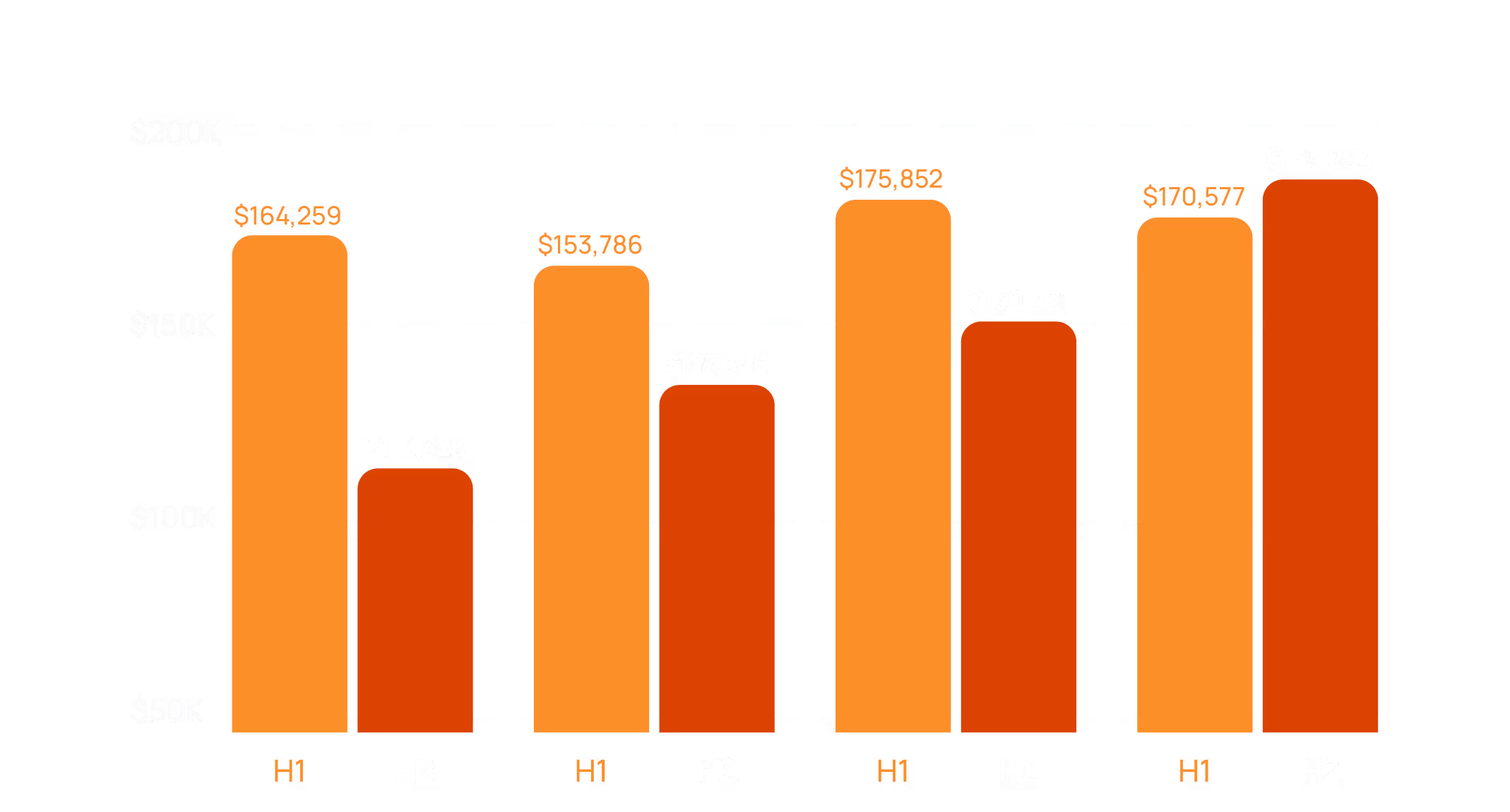
Geographical Distribution:
More of the Same
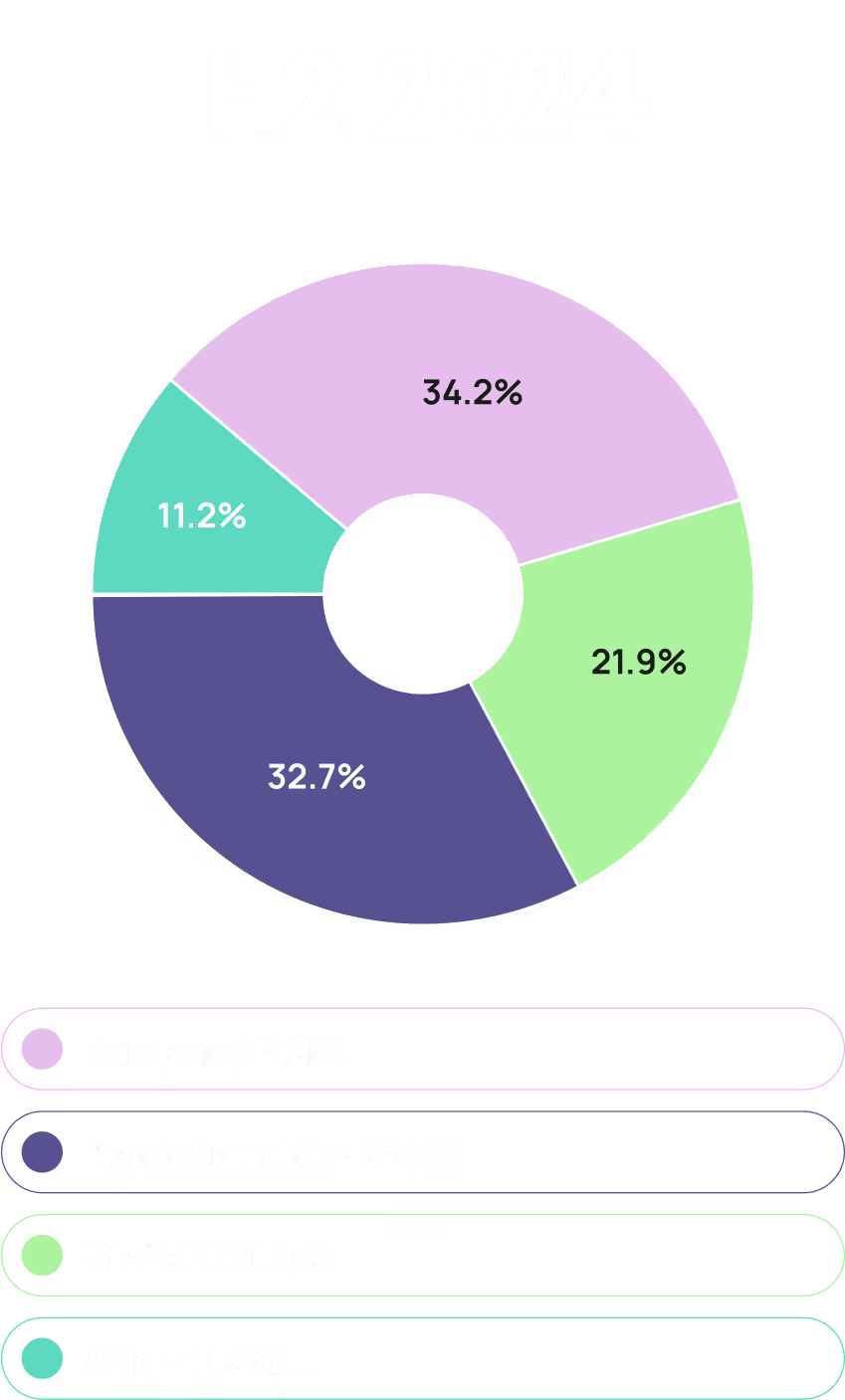
In H2, 34.2% of Web3 roles were accessible to professionals based in Europe, a slight increase from 34% in H1. Europe continues to be a key region for Web3 job opportunities, reflecting its growing role as a hub for blockchain and crypto innovation.
The average salary for Web3 roles in Europe decreased to $127,646 in H2, down from $153,786 in H1. This decline is significant, highlighting a potential adjustment in salary structures due to increased hiring at junior or mid-level positions. Despite this drop, the salary range widened, with the maximum salary rising to $325K, suggesting opportunities for top-tier roles in niche areas.
Europe remains an essential hub for Web3 activity, particularly in blockchain development and regulatory innovation. The salary decrease may reflect economic uncertainties or shifts in hiring strategies, emphasizing the importance of skills over experience in some roles.
Jobs available in North America rose to 32.7% in H2, up from 31.6% in H1. This growth reinforces North America's position as a major player in the Web3 industry, driven by its established tech ecosystem and venture capital backing.
North America experienced an increase in average salary to $183,294, up from $170,577 in H1. With the upper quartile consistently reaching $200K, North America continues to lead in salary competitiveness, underpinned by its thriving tech ecosystem and substantial venture capital investment.
The region's focus on leadership and senior roles likely drives the salary increase. Job seekers targeting North America should be prepared to demonstrate advanced expertise and leadership capabilities. Meanwhile, recruiters need to address the demand for top-tier talent with attractive compensation packages and clear career growth pathways.
Globally accessible roles increased slightly to 21.9% in H2, up from 21.5% in H1. This reflects the Web3 industry's continued focus on inclusivity, leveraging remote work to tap into talent across the globe.
Globally accessible roles saw a decline in average salaries to $150,421 in H2, down from $175,852 in H1. The broader salary range, from $36K to $300K, points to more inclusive hiring practices across various levels of experience and geographies.
The decrease in average salaries for global roles may reflect an increased focus on hiring from regions with lower average compensation expectations. For job seekers, this highlights the importance of positioning themselves competitively for remote roles. For recruiters, it suggests an opportunity to leverage global hiring to diversify their workforce while managing costs.
Roles open to Asia-based professionals decreased to 11.2% in H2, down from 13.1% in H1. This drop may be attributed to shifting regional hiring strategies or challenges in accessing the talent pool across Asia.
The average salary in Asia dropped sharply to $112,328 in H2, compared to $164,259 in H1. This decrease is coupled with a lower median salary of $100K and a narrower range, suggesting an overall reduction in senior-level or high-compensation roles.
Asia remains a promising region for Web3 talent, particularly in blockchain development and DeFi, but the reduced salaries indicate a shift toward junior or mid-level hiring. Job seekers in Asia may need to focus on global roles or upskill to compete for higher-paying positions. Recruiters could benefit from targeting untapped talent pools in emerging tech hubs across the region.
Geographical Insights for Job Seekers and Recruiters
Europe and North America remain the strongest regions for Web3 job opportunities, but the rise in globally accessible roles indicates ongoing support for remote work. Professionals in regions with fewer openings, such as Asia, may benefit from upskilling and targeting globally accessible roles to increase their opportunities.
Expanding global access to roles can help tap into diverse talent pools, especially in regions where local openings are limited. For Europe and North America, recruiters should focus on staying competitive with salaries and benefits to attract top-tier talent in these high-demand markets.
North America stands out for its consistently high salaries, offering excellent prospects for experienced professionals. Europe remains a solid choice, especially for those targeting senior roles or specialized positions. For talent in Asia or targeting global roles, upskilling in niche areas like DeFi, smart contracts, or blockchain security could help unlock higher compensation.
The increase in salary competitiveness in North America suggests a need for innovative recruitment strategies, such as equity incentives or flexible work arrangements. Europe offers opportunities to find experienced professionals at slightly lower costs, while Asia presents an attractive option for expanding junior and mid-level talent pipelines. Global roles should emphasize inclusivity and provide clear growth pathways to attract diverse and highly skilled professionals.

Summary
The Web3 job market in 2024 demonstrated strong competitiveness, with Backend Developers, Smart Contract Developers, and Management roles commanding the highest salaries. Technical expertise in languages such as Rust, Solidity, and Golang remained in high demand, with senior professionals in these areas securing top-tier compensation.
Remote work continued to dominate, with 76.5% of roles offering full remote flexibility, underscoring the industry's decentralized ethos. Hybrid roles grew significantly, reflecting a trend toward balancing flexibility with occasional collaboration. U.S.-based roles offered the highest average salaries, while globally accessible roles provided opportunities for diverse talent pools, supporting the industry's borderless hiring philosophy.
Companies showed a pronounced preference for senior hires, with 63.8% of positions filled at this level in H2. These trends highlight the demand for leaders capable of navigating Web3's complex, fast-evolving technological landscape. Mid-level roles saw a slight decline, and junior positions remained limited, emphasizing the industry’s reliance on seasoned professionals with strategic and technical expertise.
The sector's hiring patterns reflected its focus on innovation and flexibility. By offering competitive pay, decentralized work options, and opportunities for leadership, Web3 companies positioned themselves to attract top talent and drive forward the adoption of blockchain technologies.
Disclaimer: This report is based on data collected exclusively through the Calyptus platform and represents our findings for 2024. It is intended for informational purposes only and may not reflect wider market trends or align with data from other sources. We advise readers to consider this context when interpreting our report. Our analysis should be used as one of several tools in understanding the evolving landscape of Web3 hiring, roles and salaries.
Get your free report
Share your details and get last quarter's breakdown from average tech salaries to workplace preferences in Web3.





